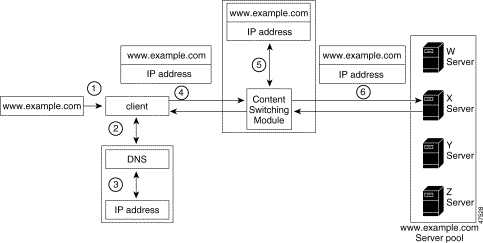|
|

The Catalyst 6000 family Content Switching Module (CSM) provides high-performance server load balancing (SLB) between network devices and server farms based on Layer 4 through Layer 7 packet information. Server farms are groups of real servers.
Server farms that are represented as virtual servers can improve scalability and availability of services for your network. You can add new servers and remove failed or existing servers at any time without affecting the virtual server's availability.
Clients connect to the CSM by supplying the virtual IP (VIP) address of the virtual server. When a client initiates a connection to the virtual server, the CSM chooses a real server (a physical device that is assigned to a server farm) for the connection based on configured load-balancing algorithms and policies (access rules). Policies manage traffic by defining where to send client requests for information.
Sticky connections limit traffic to individual servers by allowing multiple connections from the same client to stick to the same real server using source IP addresses, source IP subnets, cookies, and the secure socket layer (SSL) or by redirecting these connections using the Hypertext Transfer Protocol (HTTP) requests.
 |
Caution The WS-X6066-SLB-APC Content Switching Module is not fabric enabled. |
These sections describe the CSM:
The CSM provides these enhanced features:
Table 1-1 lists the available CSM features.
| Features |
|---|
| Supported Hardware |
|
|
| Supported Protocols |
|
|
|
| Layer 7 Functionality |
|
|
|
| Miscellaneous Functionality |
|
|
|
|
|
|
|
| Load-balancing Algorithms |
|
|
|
|
|
|
|
|
| Load Balancing Supported |
|
|
|
|
|
|
|
|
| Stickiness |
|
|
|
|
| Redundancy |
|
|
| Health Checking |
|
|
|
|
|
|
|
|
|
| Management |
|
Figure 1-1 shows the CSM front panel.

 |
Note The RJ-45 connector is covered by a removable plate. |
When the CSM powers up, it initializes various hardware components and communicates with the supervisor engine. The Status LED indicates the supervisor engine operations and the initialization results.
 |
Note For more information on the supervisor engine LEDs, refer to the Catalyst 6000 Family Module Installation Guide. |
During the normal initialization sequence, the status LED changes from off to red, orange, and green. Table 1-2 describes the Status LED operation.
| Color | Description |
|---|---|
Off |
|
Red |
|
Orange |
|
Green |
|
Green to orange |
|
| 1Enter the show environment temperature mod command to display the temperature of each of four sensors on the CSM. 2CLI = command-line interface. |
Clients and servers communicate through the CSM using Layer 2 and Layer 3 technology in a specific VLAN configuration. (See Figure 1-2.) Clients connect to the client-side VLAN and servers connect to the server-side VLAN. Servers and clients can exist on different subnets. Servers can also be located one or more Layer 3 hops away and connect to the server-side VLAN through routers.
A client sends a request to one of the module's VIP addresses. The CSM forwards this request to a server that can respond to the request. The server then forwards the response to the CSM, and the CSM forwards the response to the client.
When the client-side and server-side VLANs are on the same subnets, you can configure the CSM in single subnet (bridge) mode. For more information, see the "Configuring the Single Subnet (Bridge) Mode" section.
When the client-side and server-side VLANs are on different subnets, you can configure the CSM to operate in a secure (router) mode. For more information, see the "Configuring the Secure (Router) Mode" section.
You can set up a fault-tolerant configuration in either the secure (router) or single subnet (bridged) mode using redundant CSMs. For more information, see the "Configuring Fault Tolerance" section.
Using multiple VLANs, single subnet (bridge) mode and secure (router) mode can coexist in the same CSM.

This section describes how the traffic flows between the client and server in a CSM environment. (See Figure 1-3.)

 |
Note The numbers in Figure 1-3 correspond to the steps in the following operation procedure. |
When you enter a request for information by entering a URL, the traffic flows as follows:
1. You enter a URL. (Figure 1-3 shows www.fox.com as an example.)
2. The client contacts a DNS server to locate the IP address associated with the URL.
3. The DNS server sends the IP address of the virtual IP (VIP) to the client.
4. The client uses the IP address (CSM VIP) to send the HTTP request to the CSM.
5. The CSM receives the request with the URL, makes a load-balancing decision, and selects a server.
6. The CSM performs Network Address Translation (NAT).
![]()
![]()
![]()
![]()
![]()
![]()
![]()
![]()
Posted: Mon Mar 11 15:12:44 PST 2002
All contents are Copyright © 1992--2002 Cisco Systems, Inc. All rights reserved.
Important Notices and Privacy Statement.